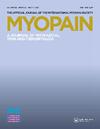Myofascial Pain in War Veterans with Post-Traumatic Stress Disorder
引用次数: 2
Abstract
Abstract Objectives: This study is aimed to investigate occurrence of myofascial pain syndrome in a group of Croatian war veterans suffering from post-traumatic stress disorder [PTSD] and to compare them with a healthy normal control [HNC] group, and to describe the most frequent locations of trigger points in the head and neck region. Methods: A total of 202 male subjects participated in the examination. They were divided into a group of war veterans suffering from a PTSD and an HNC group. The first group consisted of 101 war veterans with PTSD [mean age = 47.22 years, range = 33–73 years]; the HNC group consisted of 101 subjects [mean age = 46.72 years, range = 34–61 years] who did not participate in the War of Independence. Results: The PTSD group revealed a higher prevalence of headaches [p < 0.001], cervical spine problems [p < 0.001], jaw clicking and popping [p = 0.032], teeth grinding or clenching during the day [p < 0.001], teeth grinding or clenching while sleeping [p < 0.001], jaw ache in the morning [p < 0.001], jaw problems while chewing [p < 0.001], parafunctions [p < 0.001], muscle stiffness [p < 0.001], and trigger points [p < 0.001] than the HNC group. Conclusion: The frequency of myofascial pain among war veterans with PTSD is significantly higher than in the HNC group. Myofascial pain must be considered among patients with PTSD, and if diagnosed must be treated in order to improve primary therapy of PTSD, and to improve quality of life of the patients.创伤后应激障碍退伍军人的肌筋膜疼痛
摘要目的:本研究旨在调查克罗地亚战争退伍军人创伤后应激障碍(PTSD)的肌筋膜疼痛综合征的发生情况,并将其与健康正常对照组(HNC)进行比较,并描述头颈部最常见的触发点位置。方法:共202名男性受试者参加考试。他们被分为患有创伤后应激障碍的退伍军人组和HNC组。第一组101例患有PTSD的退伍军人[平均年龄47.22岁,范围33-73岁];HNC组包括101名未参加独立战争的受试者,平均年龄46.72岁,范围34-61岁。结果:PTSD组出现头痛[p < 0.001]、颈椎问题[p < 0.001]、下颌咔哒咔哒响[p = 0.032]、白天磨牙或咬牙[p < 0.001]、睡觉时磨牙或咬牙[p < 0.001]、早晨颌痛[p < 0.001]、咀嚼时颌问题[p < 0.001]、功能异常[p < 0.001]、肌肉僵硬[p < 0.001]、触发点[p < 0.001]的发生率高于HNC组。结论:创伤后应激障碍退伍军人肌筋膜疼痛发生率明显高于HNC组。创伤后应激障碍患者必须考虑肌筋膜疼痛,如果确诊,必须进行治疗,以改善创伤后应激障碍的初级治疗,提高患者的生活质量。
本文章由计算机程序翻译,如有差异,请以英文原文为准。
求助全文
约1分钟内获得全文
求助全文

 求助内容:
求助内容: 应助结果提醒方式:
应助结果提醒方式:


